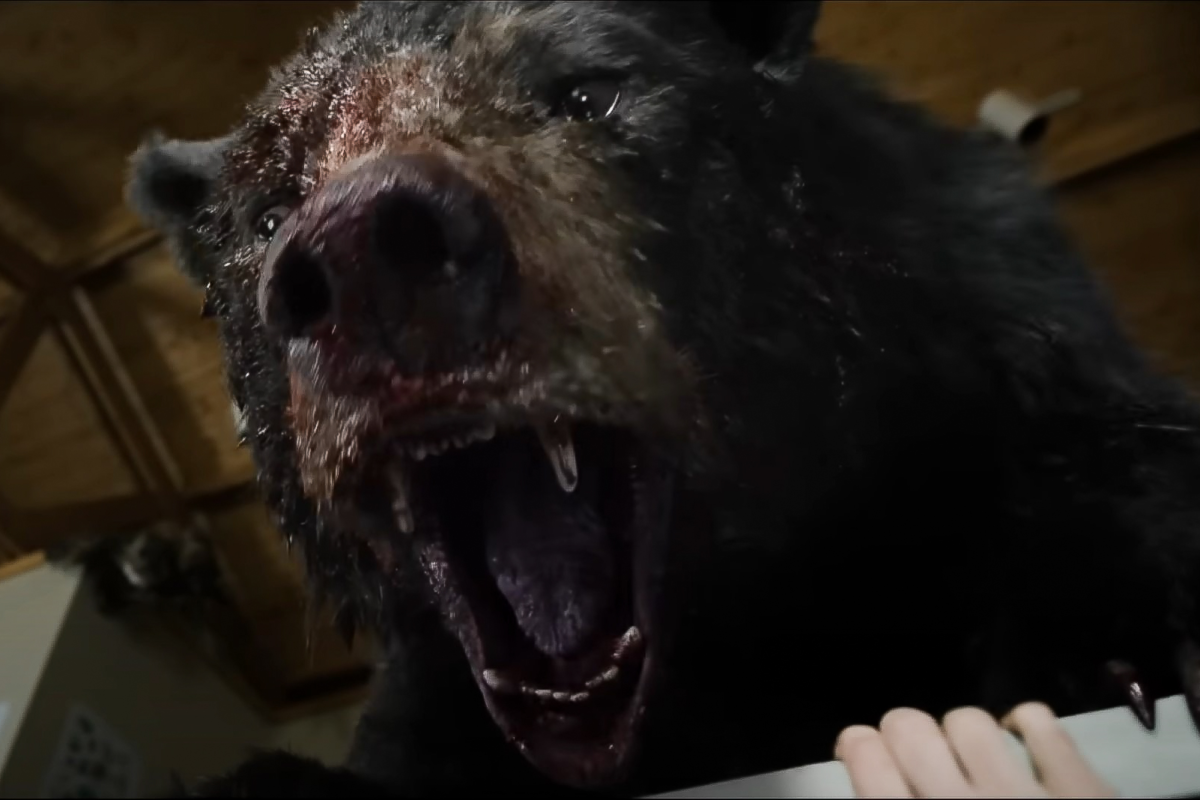Cocaine Bear, the new film by director Elizabeth Banks, has a wild premise: A bear eats a stick of cocaine, then goes berserk and kills. Did you know that there is a true story behind Cocaine Bear?
It’s a fine setup for a horror comedy, with a cast featuring Ray Liotta, Kerry Russell, Jesse Tyler Ferguson, and Alden Ehrenreich, but there’s something else about Cocaine Bear that stands out—the words “inspired by a true story” on the film’s poster.
Of course, the real story of Cocaine Bear is not like the story in the movies. There’s no Jaws-like carnage, no bunch of Hollywood actors roaming around the woods in a “hunt or be hunted” scenario.
There’s a bear, and there’s cocaine. Yes, the bear swallowed cocaine. And like most weird drug-fueled stories, it was set in the 1980s.
The Three-Sentence Story That Inspired The Cocaine Bear
In December 1985, the Georgia Bureau of Investigation made a shocking announcement: a 175-pound black bear had “died of a cocaine overdose after discovering a batch drugs”. The story appears in three sentences from United Press International and appears in national publications such as the New York Times, such as:
The cocaine allegedly cost millions of dollars and was airlifted in September by Andrew Thornton, a drug trafficker and former Kentucky narcotics investigator, when he parachuted from a plane.
Thornton was most likely trying to lose weight to avoid falling to his death. Unfortunately for Thornton, that didn’t work out. He crash-landed in Tennessee, where he was found dead with a bundle of cocaine strapped to his body.
Of course the authorities couldn’t just leave the packs of cocaine lying around in the woods. Thus, a search began for the cargo he dumped. That’s when the Georgia Bureau of Investigation (GBI) found their bear, who apparently found the cocaine first.
How Much Cocaine Did The Bear Ate?
By the time GBI agents found the bear in the mountains of Fannin County, roughly 80 miles north of Atlanta, it had been dead for about four weeks. Nearby, GBi agents found a bag, and inside were the remains of 40 packets of cocaine.
“The bear got to it before we could, and it ripped open his bag, giving itself cocaine and OD,” GBI’s Gary Garner told the Associated Press at the time. “There’s nothing left but bones and skin”. To illustrate exactly how much cocaine we’re talking about, every small packet of cocaine contains a kilogram. The bag originally contained 40 packets, so it’s 40 kilograms of cocaine.
In total, that’s about 88 pounds, and bears seem to eat most of it. Thornton, meanwhile, was only carrying 77 pounds of cocaine when he fell too hard. An AP report goes on to say that chief medical examiner Kenneth Alonso determined that the bear had only a little of cocaine in its bloodstream when it died, even though it ate much more.
“The question is: what happened to the bag?” Says Alonso, “Bears don’t account for full duffel bags”. GBI agents found another similar backpack containing another 75 pounds of cocaine nearby. This is, to be very clear, a lot of cocaine.
GBI agents found four bags all within 100 yards of the bear’s corpse—a total of at least 218 pounds of cocaine.
Who is Andrew Carter Thornton?
Once upon a time, Andrew Thornton II was a young man of great promise. The son of a wealthy Kentucky horse breeder, he later became the Purple Heart of the US Air Force.
According to a Los Angeles Times report, Thornton served in the 101st Airborne Division in the mid-60s. A friend described him as “an expert sky diver and the kind of guy who wouldn’t let anyone touch his pack”.
Another friend described him as “one of the smartest people I met. In school, he did very well. He came from a very good family and had everything in the world going for him.” After that, Thornton joined the Lexington police force in 1968, served there for nine years, and resigned in 1977.
The Turning Point Of His Life
It’s unclear what changed for Thornton. Four years later, he was arrested in California as part of a group accused of stealing guns from the China Lake Naval Weapons Center and conspiring to smuggle 1000 pounds of marijuana into the US.
Thornton managed to avoid being indicted on the weapons theft charge, but he was indicted on charges of conspiracy to import controlled substances and conspiracy to distribute controlled substances.
Thornton allegedly piloted a small plane in 1979 that smuggled narcotics from South America to Kentucky. He pleaded not guilty in the case, fled California, and arrested as a fugitive in North Carolina. When arrested, he was wearing a bulletproof vest and carrying a revolver.
He sentenced to six months in prison, a $500 fine, five years of probation, and, understandably, the suspension of his legal license.
His Final Years
In 1981, reports came in that Thornton had formed a Lexington Police Department intelligence squad. What’s more, the group he accused of abetting has links to a much larger group known as the “Company”.
Meanwhile, Thornton doesn’t seem to have missed his drug-smuggling days. On September 11, 1985, police found his body in the driveway of a house in Knoxville, Tennessee, with a bunch of cocaine tied to him. “I’m glad the parachute didn’t open,” said the district attorney who sued Thornton in 1981. “I wish him great results”.
The True Story of Cocaine Bear
So, there you have it. The true story behind Cocaine Bear honestly has less to do with bears and more to do with a man. A man who had seemingly everything going for him, became involved in the drug trade, and died in ironic circumstances.
Honestly, it could be a pretty good movie too, though it’s a lot more serious. Elizabeth Banks’ films are, of course, only inspired by true events and not beholden to them.


